Monuments in Harlington Church, St Peter & St Paul, South Hillingdon, Middlesex
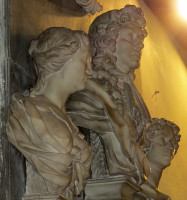
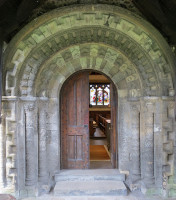
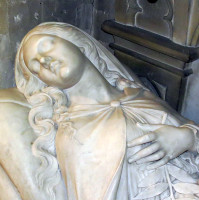
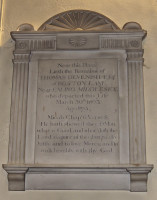
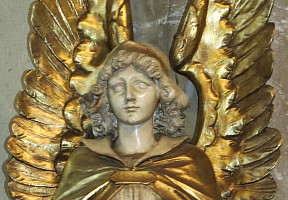
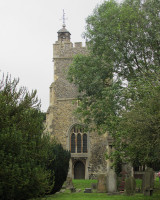
The medieval Parish Church of Harlington, dedicated to St Peter and St Paul lies somewhat
to the south of West Drayton Church, still in South Middlesex,
a not particularly pleasant walk along the main road from Harmondsworth.
From the point of view of these pages, centred on sculpture and monuments, the Church is of interest
for three important figural ones: Sir John Benett, and the two figures of the Count and
Countess De Salis. In addition, there is a portrait bust and relief portrait, both again from the
De Salis family, and also several minor tablets, including one by the local firm of
Burgiss of Uxbridge, and medieval brasses.
Aside from monuments, there is the ancient fabric of the Church itself: let us start briefly with that.
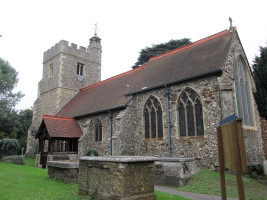 Harlington Church, St Peter and St Paul.
Harlington Church, St Peter and St Paul.
Harlington Parish Church dates in its oldest portions from the 12th Century, including parts
of the nave and most prominently, the South Door (see picture at top of page), with characteristic round arch,
four concentric orders, one with Norman chevrons, and one with strange little carved heads,
lions apparently, and certainly feline (see this page if you want more examples of lion heads).
Much of the rest of the fabric is 14th and 15th Century, including the battlemented tower,
three storeys high and with a small turret.
Inside, the open roof, with its many rafters and great beams spanning the nave,
is apparently 14th Century too, and together with the wooden pews, though these are relatively
modern, gives an evocative and medieval ambience to the interior.
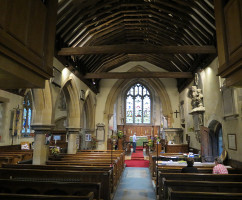
Principal Monuments
- Sir John Benett, d.1686, listing his august titles: ‘Knight of ye Hon.
Order of the Bath, Lord Ossulston, Baron of Ossulston, in the County of Middlesex,
Lord of this Mannor, a Patron of this Church’. The monument also commemorates his two wives,
firstly Elizabeth, Countess of Mulgrave, daughter of Lyonell Cranfeild,
Earle of Middlesex, and the second being Bridget, daughter of John Howe
of Langor in Nottingham. A massive monument indeed, divided into two portions, the top centred on
the bust of Sir John, flanked at lower level by his two wives, and with a coat of arms above
on a fine cartouche. There is a solid central shelf, and then the lower half contains
the inscription, with winged cherubic heads to the sides and below, joined by a garlands of
delicately carved flowers.
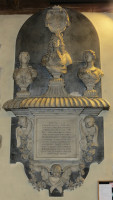
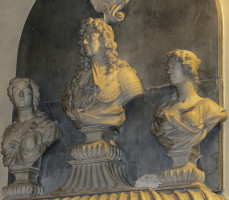
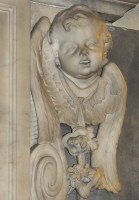
Monument to Sir John Benett, d.1686, and his wives.
The portrait bust of Sir John shows a haughty face, really not unusual for portraits of the
17th Century, carved with an expressive and variable contour, a full wig of curly locks
falling over his shoulders, and a neck encircled by a flamboyant neck-scarf.
Below, we see his ornamented armour, covered in part by a cloak. Which wife is which?
I would guess that the one on his right, or the viewer’s left, should be the Countess,
and she seems older than the other. The sculptural treatment of her hair is very successful,
with wavy swirls, lying along both sides of her neck, and with one loop across shoulder and breast.
She wears classical drapes knotted between the breasts in Baroque fashion. The bust of Elizabeth,
presuming the identification with the bust on the right hand side of the viewer is correct,
shows a more youthful figure, with long columnar neck. Her hair, more ringletted than wavy frames
her forehead nicely, and winds down in a single long ponytail, wound round her neck.
Her drapery consists of an outer garment on top of a thinner chemise with a border.
The three portraits together form a harmonious group and exemplify the high standard of
craftsmanship the late 17th Century sculptor could obtain.
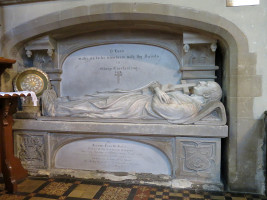
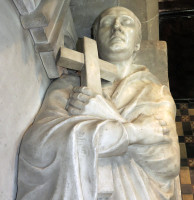 Count Jerome fane De Salis, d.1836, by R. C. Lucas.
Count Jerome fane De Salis, d.1836, by R. C. Lucas.
- Jerome fane De Salis, d.1836, ‘Count of the Germanic Empire’.
This monument and that to his wife flank the altar on opposing walls of the sanctuary.
Each is formed by a niche in the wall within which is erected a tomb chest with upon it a recumbent
carved effigy of the deceased, and behind, on the rear wall of the niche,
further architectural decoration. The figure of De Salis lies supported on a turned-over
thin mattress forming a pillow, so his uplifted head faces upwards and towards the East end
of the Church. He is wearing a long, enfolding robe, with the sleeves of his arms protruding,
but covering his feet entirely. His hands are crossed over his chest, and in his left hand he holds
a large crucifix. His head, with high, domed forehead and thin hair at the back, closed eyes,
fine Roman nose, and thin lips, has an ascetic air, ‘benevolent, learned and pious’
in the words of his epitaph. The treatment of the drapery is clever; we see something both
of the effects of gravity, and of the folds hanging downwards towards the feet,
so that if stood up, the effigy would still look more or less correct. On the front of the
chest tomb underneath is the inscription under an arch; the remainder of the frontage being
occupied by two spandrels and two carved coats of arms at the ends.
The design is echoed by the back of the niche, with a wide, shallow arch above a central marble
panel, and the back and front acting as pilasters, above which hang pendants.
The statue is by Richard Cockle Lucas, a sculptor of some renown, who made the monument to
Richard Colt Hoare at Salisbury Cathedral among others.
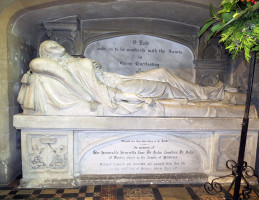
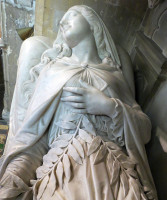 Countess Henrietta fane De Salis, d.1856, by William Theed Yr.
Countess Henrietta fane De Salis, d.1856, by William Theed Yr.
- The Honourable Henrietta fane De Salis, Countess De Salis, d.1856,
of Pawley Court in the County of Middlesex. The overall design is similar to that of the Count,
with tomb chest below, lying figure above, arch over inscription and arch behind,
but the pose of the figure could not be more different. The Count is shown lying flat
apart from his raised head, formally arranged with crossed arms, and legs symmetrically straight out
with the feet resting next to one another. By contrast the Countess has her back and
neck raised far higher, her legs crossed, hands asymmetrically disposed and head turned outwards,
as if she was in restless sleep and about to awaken. She is a beauty – young,
with symmetrically rounded face, plump in the cheek and chin, eyes shut but with obviously large
orbs, the slender nose of a patrician and full lips denoting youth and seductiveness.
She wears a mantle over a thin garment which as for her husband, covers the feet,
though leaving them nicely outlined to show the delicate arch of the foot from rounded heel
to charming toe; her arms are sleeved and frilly. Her hands are perfect and expressive with slender,
tapering fingers: one rests on her breast, above her heart, with under it two branches of olive;
the other hand, by her side, holds a plucked stem bearing two roses, one open, one a bud
plucked before it could ripen. Truly an exquisite memorial. The sculptor was
William Theed the Younger, a most prolific Victorian sculptor
who made many good things, including three figures for Burlington House,
home of the Royal Academy, and statues across England including several in Manchester (see this page).
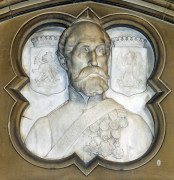 Lieutenant General Bodolph Fane De Salis, d.1880.
Lieutenant General Bodolph Fane De Salis, d.1880.
- Lieutenant General Bodolph Fane De Salis, Colonel of the 8th Regiment
of Hussars at Balaclava, d.1880, by J. Edgar Boehm,
another notable sculptor of the period, who specialised in male portraits,
and whose most well known work is the statue of Wellington on horseback
facing his residence at Hyde Park Corner,
and surrounding figures. It is made as the top of a broad Tudor portico,
with the inscription across the whole width, and above, in what might be termed a Gothic pediment,
were there such a thing, is a bust of the deceased in a quatrefoil; the surround being in stone,
the bust in white marble. We see an elderly man, with beard, heavily whiskered,
and a look of fortitude and stubborn endurance. He wears a turned-up collar to his military jacket,
and many medals, and lightly carved in the background are two coats of arms, crowned.
- William Fane de Salis, d.1896, and wife Emily Harriette, d.1896, unfortunately with seating
now against the monument; we can appreciate the need while deploring the necessity.
At least the profile portrait in low relief can be seen, as an elderly man with sideburns
and a determined but somewhat careworn look; he reminds me of Trollope’s The Warden.
The surround is the central portion of a Tudorish Gothic pediment of stone, with the portrait
in a whiter marble roundel and surrounded by groups of three small baubles,
and with carved flowers, rather stylised, in squares on the frame.
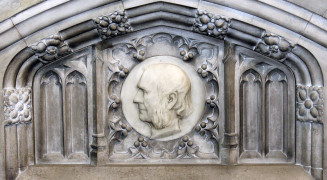 William Fane de Salis, d.1896.
William Fane de Salis, d.1896.
Other monuments:
There are several other monuments in the form of simple wall plaques, which we note in date order:
Ancient brasses:
Modern brasses:
Also in the Church:
Churchyard
Outside, the Churchyard stretches off in a long, relatively thin piece of greenery enclosed
by a brick wall, fence, and hedge, with thick yew trees near to the Church so that the
further areas feel remote. The monuments have been kept mostly free of ivy,
but allowed to sink into the soft ground, slumping and cracking and collapsing.
Near the Church is the World War I memorial, as a granite Churchyard cross
in Celtic form, with characteristic looping geometric designs on the crucifix, a bare shaft,
and the inscribed names of the fallen on the heavy base, with a step below.
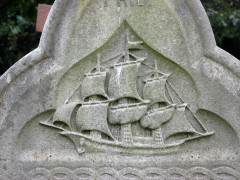 Carved ship in relief on the Hohlsson tombstone.
Carved ship in relief on the Hohlsson tombstone.
We see a couple of tomb-chests, from the beginning of the 19th Century and later,
and rather more graves of the form of an enclosed plot long enough for the coffin,
with stone surround, raised corners, and at the top, a headstone or crucifix raised on steps.
One or two ledger stones too, with cracked, broken and sunken tops.
There is a small amount of sculptural decoration here and there, mostly from the early 20th Century:
a ship in relief on the tombstone of Captain Olof Hjalmar Hohlsson,
born at Ellishult, Sweden, and died in Harlington in 1920, and his wife Emelie Albertina,
also from Sweden; the odd headstone as a carved book; a couple of little angels,
and a relief of a pensive young woman, standing finger to lip, in memory of her devoted husband
Percy A. Salter, d.1934; a few bits of broken pots from collapsed tombs placed
in a corner. And a very late Arts and Crafts tomb, in terra cotta, to Herbert Wilson, d.1929,
Rector or Harlington, with a large collapsed crucifix and two kneeling infant angels.
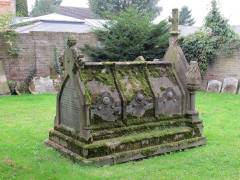 Mid-19th Century Gothic chest tomb.
Mid-19th Century Gothic chest tomb.
With many thanks to the Church authorities for permission to show pictures of the monuments inside; their website is
http://www.stpeterandstpaul-harlington.org.uk/church-history/.
Top of page
West Drayton Church, Hillingdon // Harmondsworth Church // Cranford Parish Church // Hayes Church // Uxbridge Church // Hillingdon Parish Church
Burgiss of Uxbridge, stonemasons // Monuments in some London Churches // Churches in the City of London // Introduction to church monuments
Angel statues // Cherub sculpture
London sculpture // Sculptors
Home
Visits to this page from 1 Nov 2014: 8,798






 Harlington Church, St Peter and St Paul.
Harlington Church, St Peter and St Paul.




 Countess Henrietta fane De Salis, d.1856, by William Theed Yr.
Countess Henrietta fane De Salis, d.1856, by William Theed Yr.
 William Fane de Salis, d.1896.
William Fane de Salis, d.1896.
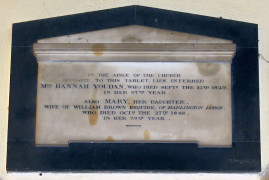 Early 19th Century: plain panel to Hannah Youdan by E. Burgiss.
Early 19th Century: plain panel to Hannah Youdan by E. Burgiss.
 Carved ship in relief on the Hohlsson tombstone.
Carved ship in relief on the Hohlsson tombstone.
 Mid-19th Century Gothic chest tomb.
Mid-19th Century Gothic chest tomb.